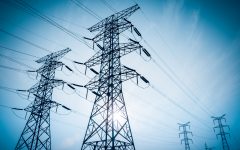
Photovoltaic (foreground) and Solar water heating (rear) panels located on rooftops in Berkeley, California. (Photo: Public Domain)
Ringside: The Potential of Rooftop Solar
Rooftop photovoltaics bring power directly into the urban areas where the power is consumed
By Edward Ring, February 22, 2024 2:40 am
 California’s central planners are determined to stay ahead of the entire world when it comes to renewable energy and achieving “net zero.” It is an expensive and intrusive experiment, and we’re the lab rats. But that doesn’t mean every renewables innovation is bad. And for the hardened skeptics, we can put it another way: At the very least, some solutions are less bad than others.
California’s central planners are determined to stay ahead of the entire world when it comes to renewable energy and achieving “net zero.” It is an expensive and intrusive experiment, and we’re the lab rats. But that doesn’t mean every renewables innovation is bad. And for the hardened skeptics, we can put it another way: At the very least, some solutions are less bad than others.
In that spirit, an examination of photovoltaics is worth considering, in particular if they are hosted on rooftops. To begin with, apart from, maybe, geothermal energy, photovoltaics use less space than other renewables. Far less space.
Corn ethanol, a popular biofuel, is the prime example. A good yield for corn ethanol is 500 gallons per acre. Depending on the use, according to the U.S. Dept. of Energy, a gallon of ethanol contains around 80,000 BTUs. Since a kilowatt-hour is 3412 BTUs, it’s a simple matter to calculate that corn ethanol will yield 6.75 gigawatt-hours per square mile per year. Since California’s voracious appetite for electricity in 2022 was 287,000 gigawatt-hours, then even if 100 percent of the energy in corn ethanol could be converted into electricity (it’s more like 40 percent), it would take 42,000 square miles of cornfields to supply California’s electricity requirements.
Another favored renewable, of course, is wind. So how’s wind doing in terms of land required? Much better than biofuel, that’s for sure. The Tehachapi Wind Resource Area is one of California’s best sites for wind turbines. From observing the rows of 1.5 and 3.0 megawatt turbines using Google satellite imaging, they appear to average around 20 per square mile. Making this assessment is an inexact science, but the areas with larger 3.0 megawatt turbines typically number around 20 per square mile. Even if all of them had a 3.0 megawatt capacity, at a yield of 25 percent, they would generate 131 gigawatt-hours per square mile per year. That means to supply California’s electricity demand in 2022 using land based wind turbines would require 2,184 square miles.
But what about solar? Here’s where it gets really interesting. At 12.5 watts per square foot, a yield of 25 percent, and allocating 50 percent of the land on the solar farm for space between the panels, access roads and interconnections to the grid, it would only require 750 square miles of photovoltaic panels to generate 100 percent of California’s electricity consumed in 2022.
Biofuel, 42,000 square miles. Wind farms, 2,184 square miles. Solar farms, 750 square miles. When it comes to renewables, does this help you pick your poison? But the story gets better. Why not put these panels on rooftops? Is there room?
According to a NREL study conducted in 2016, there were just over 10 billion square feet of usable rooftop space in California for PV. Massive warehouse construction and ongoing construction of all types – even a few homes – since then mean this number has only increased. But 10 billion square feet, at 12.5 watts per square foot and a 25 percent yield means if 100 percent of California’s usable rooftop space had photovoltaic arrays, it would generate 273,750 gigawatt-hours, nearly equivalent to California’s entire 287,220 gigawatt-hours of electricity consumption in California in 2022.
For this reason, California’s state Legislature should think twice about taking away the financial incentives for homes and businesses to install rooftop photovoltaics. Photovoltaics on rooftops don’t use up farmland, nor do they despoil any other outdoor environments. Every photovoltaic panel on a roof is one less photovoltaic panel diminishing farm output or disrupting a desert tortoise.
Rooftop photovoltaics have other virtues. They bring power directly into the urban areas where the power is consumed, dramatically reducing the need for additional transmission lines. And every one of them, presumably, will be managed and maintained by private property owners, reducing the burden on utility companies.
Another interesting virtue of rooftop photovoltaics is their potential to exist immediately adjacent to distributed storage in the form of vehicle-to-grid enabled EVs and hybrids. Note to skeptics: Even if EVs may not be there yet, hybrids are definitely ready for prime time. And once again, bidirectional charging stations in parking areas adjacent to buildings can be decentralized and privately managed and maintained. Drive your car to work, charge all day, then drive it home and let it power your home when the sun is down.
Decentralized generation, decentralized storage. Massive private investment in small-scale independent, vertically integrated power providers. Who could possibly object?
This is not the least bit infeasible. If only 10 percent of California’s 14.3 million registered automobiles (that doesn’t include any commercial vehicles) were EVs with 50 kilowatt-hour batteries, they would have a total storage capacity of over 70 gigawatt-hours. California’s goal for total utility scale storage by 2045 is only 52 gigawatt-hours.
It is unrealistic to expect renewables to replace all of California’s energy requirements. Retrofitting our fleet of natural gas power plants, drilling and refining our oil and gas in-state, expanding our nuclear energy capacity, and continuing to develop geothermal energy are all necessary if Californians are serious about maintaining an abundant and affordable energy supply, and setting an example that other states and nations will enthusiastically follow.
Moreover, the cautionary facts surrounding renewables must be acknowledged, starting with the tremendous consumption of resources it takes to build them, their relatively short service life and recycling costs, and the tremendous amount of space required to deploy them. But rooftop solar, buffered with a fleet of advanced hybrids and EVs with onboard vehicle-to-grid technology, is a combination that might well belong in the mix.
- Ringside: The Potential of Waste-to-Energy in California - April 17, 2024
- Ringside: How Much Water Will $30 Billion Buy? - April 10, 2024
- Ringside: Sacramento’s War on Water and Energy - April 4, 2024




If I may share an experience. I got my solar system for free, thanks to the generosity of the taxpayers and Elon Musk’s Sun City program. Wisely, I chose the option of not owning the panels and paying a fee per kilowatt. Essentially, they rented my roof.
The January storm in Sacramento flooded and shorted out my panels. Tesla came out and replaced them for free. If I had bought them out right , that repair would have been on me. That my friends, is an issue you should address before you sign up.
My son had solar panels installed on his roof here in Sacramento. He was limited as to how many he could have. With the state crying about not having enough power and wanting everyone to go Green, it defies common sense that he could not have had more panels installed. Bunch of hypocrites.
My objection to residential rooftop solar is the government mandate that all new homes are required to have it installed. This increases the cost of new homes. Eventually, the government will mandate that all homes be retrofitted with solar. This always happens with when government gets involved. Rooftop solar should be voluntary on the part of home owners.
Yes, Raymond. And there are a lot of problems with rooftop solar, in addition to what Edward Ring noted. They can damage and thus compromise the integrity of your roof. Rainstorms can cause problems, shortouts, etc., as Chuckiechan described above. (And who needs the grief, even if “free-subsidized,” of replacing one’s precious solar panel array every time it rains hard? Or there is a freeze? Or…?) The sun doesn’t always shine (even in California, as we have often seen). The panels have to be maintained, wiped down regularly, to function properly (another hassle and more money spent if you don’t or can’t do it yourself). Properties that have a lot of shade trees (which govt pests have historically nagged homeowners to plant, to provide shade to save energy, because “climate change,” sigh) can’t install solar because it won’t work. Backyard animals chew on the wires. Solar companies have an alarming tendency to go out of business and the homeowner is stuck. The panels are UGLY. Etc.
Agreed. It should not be mandated.
I have a neighbor who spent a small fortune on solar thinking he would go all electric. He has a Tesla which he loves even though he had to spend nearly 20 grand to replace the battery because he ran over a rock. After several years he says the solar was probably a waste of money. He does still own a diesel pickup which goes to show he still has some common sense.
I must add that the timing of this article is rather strange. I checked the date to see if it was from 10 years ago but no it is current. Solar and EV’s are collapsing due to their inefficiency both economically and practically. Even leftist media outlets have started to notice.
What is really collapsing, and hopefully soon, is offshore wind. As noted in the article, biofuel is another completely unrealistic and environmentally damaging path to renewable energy. Pick your poison.
There are lots of ongoing problems with solar panels, and with batteries, particularly with the technologies we have today. That’s why they are failing to break out of the niche markets they’ve captured so far. But solar PV already can work in places where there is a lot of year-round sun, and while EVs aren’t ready for universal adoption, purchasing a hybrid does make financial sense. Look at the Toyota models, they have the most durable and cost-effective systems.
It would be crazy to try to move everything to renewables overnight, which is what California’s insane legislature is trying to do. But it would also be shortsighted to not aggressively research innovations in PV and battery technology. Solid state batteries are coming along and if they can be commercialized they will erase a lot of the concerns we have today with lithium ion technology. When it comes to energy, and water, I favor the all-of-the-above approach.
I prefer Democrat experimental vacuums designed for human exposure be delayed until chimp, guinea pig and rat mortality end.
In 2018 a friend told me about the Power Purchase Agreement she’d done with Vivint Solar. We listened to the spiel and were then approached by a different solar company, ending in a bidding war between them. We eventually signed up with Vivint (now Sunrun), paying $.149 kWh on the power produced from our panels, which increases 3% per year. We also had it installed on all of our rental houses, which we have since sold. Currently our cost is $.1718 per kWh and our bills in 2023 were between $26.81 and $142.58, with our true up being $187.17. We pay between $5-6 per month to PG&E as well. Total for Sunrun and PG&E last year was $1249.86. Our house is 1850sf, there are just 2 of us, and we’re fairly conservative with our energy use. We don’t own the equipment, so any repairs are paid by Sunrun. We are unable to clean them and don’t want to pay anyone to do that task.
With where power prices are going, this is an excellent deal for us. If we didn’t have this program, we would be forced to purchase solar or go broke paying 50 or 60 cents a kWh! At least until we can get out of California!!